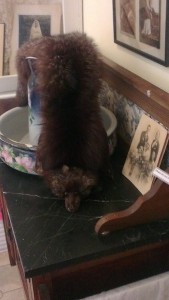It’s been a very long year, topped off with a flurry of interviews and resignation and appointments and getting ready to move and start new job. Exhaustion settling into finally taking a break was interrupted for one day for a quick trip to Darling.
Darling is a (very) small town in the West Coast/ Winelands area of the Western Cape. It’s probably best known as the home of Evita se Peron, although the town itself is much less arty than that would imply. Far less art and theatre-inclined than some of the towns on the R66.
Most of Darling is small settler farming town, set in rolling hills and dry, Karoo-like land. Dusty streets with names like Kerk, Pastorie and Queen Victoria. Houses built with thick walls and tin roofs, picture windows and wrap-around verandas. We stopped at the Presbyterian Church first. It’s a pretty church that looks like what you think a settler or frontier church should look like. Narrow building with steep sloped roof, topped with a cross, and a large, deep bell (I don’t really know if it was deep but it feels like it should have been).
After that, we popped next door to the Darling museum. Some museums are state or academic institutions that work hard to build up collections and to document the past in a systematic way, ensuring balance and fidelity. This isn’t one of those. Still, there is sometimes something delightfully idiosyncratic about a private museum with a collection built solely on the items that individual families choose to donate. This one had definite flashes of delight.
The first room was set up to document home and town settler life, with rough recreations of dining-rooms, bedrooms and gardens. The bedroom included, among other things, his and hers grooming sets with those silver-backed brushes that look like they’d struggle to make a dent in the hair of an infant, let alone an adult. Particularly when one considers that settler women tended to wear their hair long and thick. As in several such museums, there is also a doctor’s room, possibly designed expressly to encourage visitors to be thankful for the comforts and luxuries of modern medicine. Of particular interest in the Darling Museum, is a steam engine recently uncovered in the area that was used in the original Swedish Dairy.
A little further along is a room with church history from the area, unfortunately currently being restored after a water leak, but including one of the original pretty stained glass windows from the Presby church. There is also a small room of bridal-wear and women’s clothes. Some pretty dresses, some really not attractive at all – apparently bad taste is timeless. Also several dead things that women would have worn around their shoulders.
Next, a room on butter making. Yes, totally quirky but quite fun. Also a little bit about the wars. Including a bit about the Anglo-Boer War (South African War) action that took place in this part of the world. Somehow, I always picture the South African War being primarily a Transvaal/Free State affair. I was surprised to discover, a few years back, that the small town of Stutterheim near East London in the Eastern Cape was involved. Even that didn’t have actual fighting. Apparently there is a moment outside of town to the Afrikaner leader who perished after the British took back Darling after he’d captured it.
Alongside the main part of the museum is a barn full, we were told, of agricultural implements. Actually, what it is mostly full of is transportation history – horse-carts and ox-wagons, what must be an ancestor of a combine harvester and even the tanks and stands from an old shell garage. It’s quite an impressive collection for a small town museum.
After the museum, we drove around town. This did not take long. Darling has some lovely houses and some pretty churches, a wine estate on the edge of town, a few shops, a hotel and that is about all. Some of the roads are tarred. There is also a “mall”, by which they mean an old converted house that now houses a bookshop, a cafe and a few other small shops. Sadly it appeared closed on a Saturday afternoon.
After Darling, we took a quick swing through Ysterfontein to see the sea before heading back to Somerset West. Also, a very strange farm stall inviting visitors to stop and see their black panthers, tigers and brown and white lions.
Dusty settler towns like Darling always make me wonder if I’ll find myself, one day, in a similar dusty, small town in another part of Africa and if it’ll feel anything like Darling.
